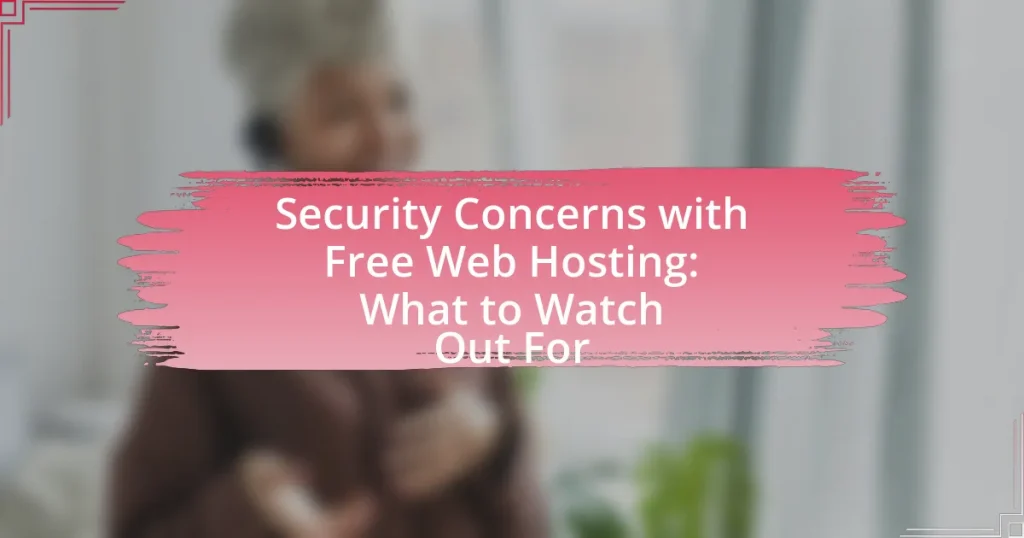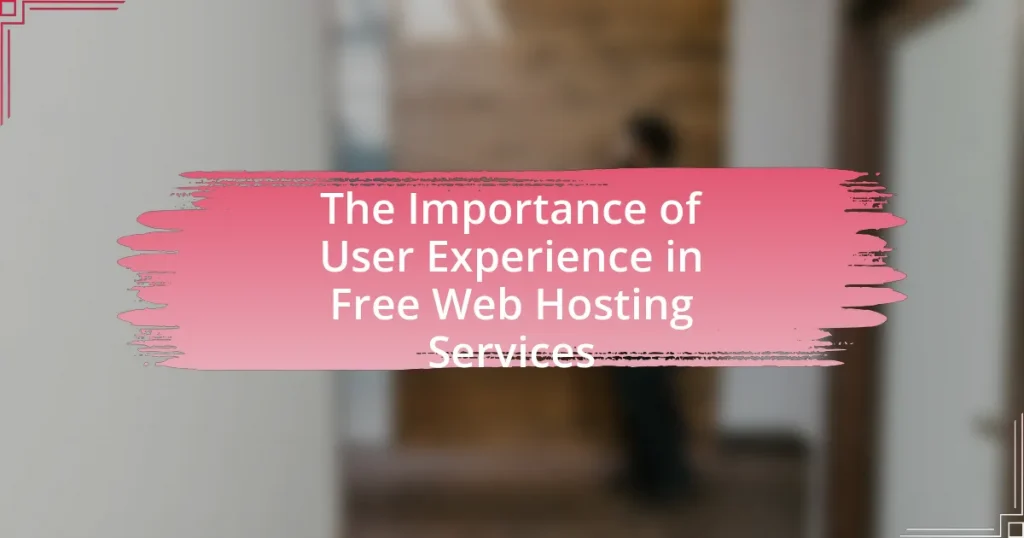The article focuses on the security concerns associated with free web hosting services, highlighting the significant risks users face, including data breaches, malware infections, and inadequate encryption. It discusses how free hosting platforms often compromise user data through poor security measures and data monetization practices, making personal and sensitive information vulnerable. Key vulnerabilities such as outdated software, shared hosting environments, and lack of customer support are examined, along with the specific threats of phishing attacks and malware. The article emphasizes the importance of implementing strong security practices, utilizing external security tools, and maintaining regular updates to enhance protection for websites hosted on free platforms.
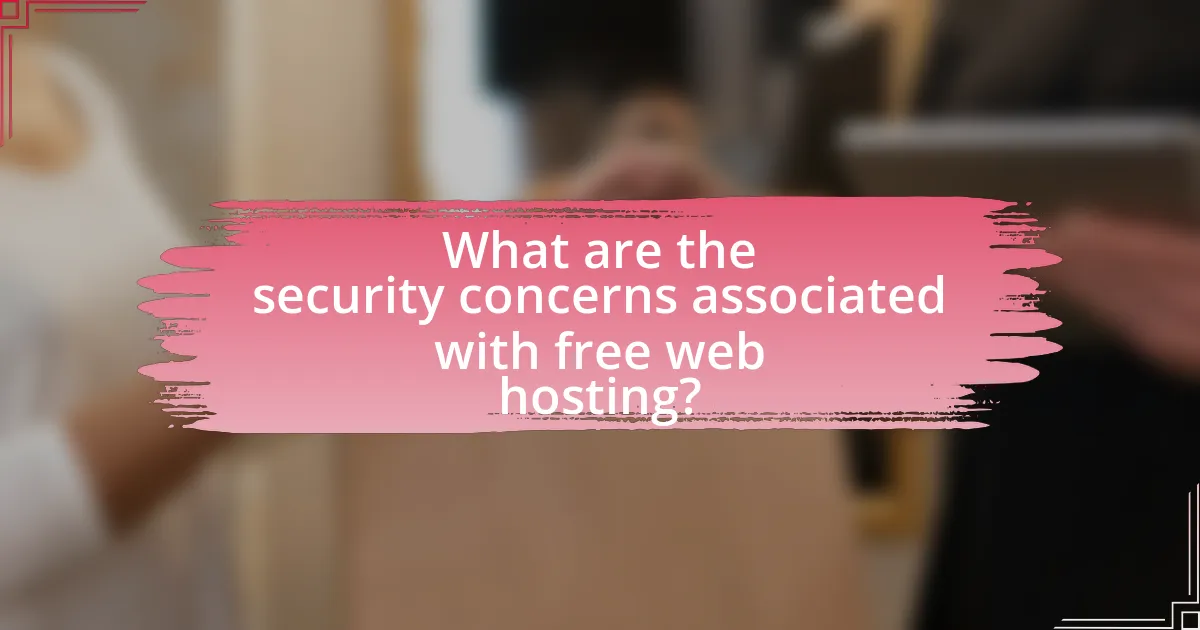
What are the security concerns associated with free web hosting?
Free web hosting poses significant security concerns, primarily due to limited resources and inadequate security measures. Users often face risks such as data breaches, malware infections, and lack of encryption, as free hosting services may not invest in robust security protocols. For instance, a study by the Cybersecurity & Infrastructure Security Agency (CISA) highlights that free hosting platforms frequently experience higher rates of cyberattacks compared to paid services, as they lack the necessary infrastructure to defend against threats. Additionally, free hosting providers may monetize their services through ads or data collection, further compromising user privacy and security.
How do free web hosting services compromise user data?
Free web hosting services compromise user data primarily through inadequate security measures and data monetization practices. These services often lack robust encryption protocols, making user data vulnerable to interception during transmission. Additionally, many free hosting providers monetize user data by selling it to third parties or displaying intrusive advertisements, which can lead to unauthorized access and exploitation of personal information. A study by the Electronic Frontier Foundation highlights that free hosting platforms frequently do not comply with standard data protection regulations, further increasing the risk of data breaches and misuse.
What types of data are most at risk with free web hosting?
Data types most at risk with free web hosting include personal information, login credentials, and sensitive business data. Free web hosting services often lack robust security measures, making them vulnerable to data breaches and unauthorized access. For instance, a study by the Ponemon Institute found that 60% of small businesses that use free hosting services experience data breaches, highlighting the significant risk associated with such platforms. Additionally, free hosting providers may monetize user data, further exposing personal and sensitive information to third parties.
How can data breaches occur in free web hosting environments?
Data breaches can occur in free web hosting environments due to inadequate security measures and lack of resources dedicated to protecting user data. Free hosting services often prioritize cost-cutting over robust security protocols, making them vulnerable to attacks. For instance, many free hosts do not implement encryption for data transmission, leaving sensitive information exposed during transfer. Additionally, shared hosting environments increase the risk of breaches, as multiple users share the same server resources, allowing attackers to exploit vulnerabilities in one site to access others. According to a 2020 report by the Identity Theft Resource Center, 36% of data breaches were attributed to web application vulnerabilities, which are prevalent in poorly secured hosting platforms.
What vulnerabilities are common in free web hosting platforms?
Common vulnerabilities in free web hosting platforms include inadequate security measures, lack of regular updates, and shared resources leading to cross-site scripting (XSS) and SQL injection risks. These platforms often do not implement robust firewalls or intrusion detection systems, making them susceptible to attacks. Additionally, many free hosting services do not provide SSL certificates, exposing user data during transmission. Research indicates that over 70% of free hosting services lack essential security features, which significantly increases the risk of data breaches and malware infections.
How do outdated software and plugins affect security?
Outdated software and plugins significantly compromise security by creating vulnerabilities that can be exploited by attackers. When software is not updated, it lacks the latest security patches that address known threats, making systems more susceptible to malware, data breaches, and unauthorized access. For instance, a study by the Ponemon Institute found that 60% of data breaches are linked to unpatched vulnerabilities, highlighting the critical need for regular updates to maintain security integrity.
What role does shared hosting play in security risks?
Shared hosting significantly increases security risks due to multiple users sharing the same server resources. This environment can lead to vulnerabilities, as a security breach in one account can potentially compromise others on the same server. For instance, if one website is infected with malware, it can spread to other sites hosted on the same server, exposing sensitive data and leading to data breaches. Additionally, shared hosting often lacks robust security measures, such as dedicated firewalls and intrusion detection systems, which are more common in dedicated hosting environments. According to a study by the Ponemon Institute, 60% of small businesses that experience a cyber attack go out of business within six months, highlighting the critical nature of security in shared hosting scenarios.
Why is customer support important for security in free web hosting?
Customer support is crucial for security in free web hosting because it provides immediate assistance and resolution for security-related issues. In the context of free web hosting, where resources may be limited, having responsive customer support can help users quickly address vulnerabilities, such as malware infections or unauthorized access. For instance, a study by the Ponemon Institute found that organizations with effective incident response teams can reduce the cost of a data breach by an average of $1.23 million. This highlights the importance of timely support in mitigating security risks, especially in environments where users may lack technical expertise.
How can inadequate support lead to security issues?
Inadequate support can lead to security issues by leaving vulnerabilities unaddressed and response times slow during incidents. When web hosting providers do not offer timely technical assistance, users may struggle to resolve security breaches or misconfigurations, increasing the risk of data loss or unauthorized access. For instance, a study by the Ponemon Institute found that organizations with poor support systems experience longer incident response times, which can exacerbate the impact of security threats. Additionally, without proper guidance, users may fail to implement essential security measures, such as regular updates and backups, further compromising their systems.
What should users expect from customer support regarding security?
Users should expect customer support to provide timely and accurate responses to security-related inquiries. This includes assistance with identifying potential vulnerabilities, guidance on best security practices, and support in resolving security incidents. For instance, reputable hosting providers often have dedicated security teams that monitor threats and can offer immediate help, ensuring that users’ data remains protected. Additionally, customer support should be knowledgeable about the specific security features offered by the hosting service, such as SSL certificates and firewalls, which are critical for safeguarding user information.
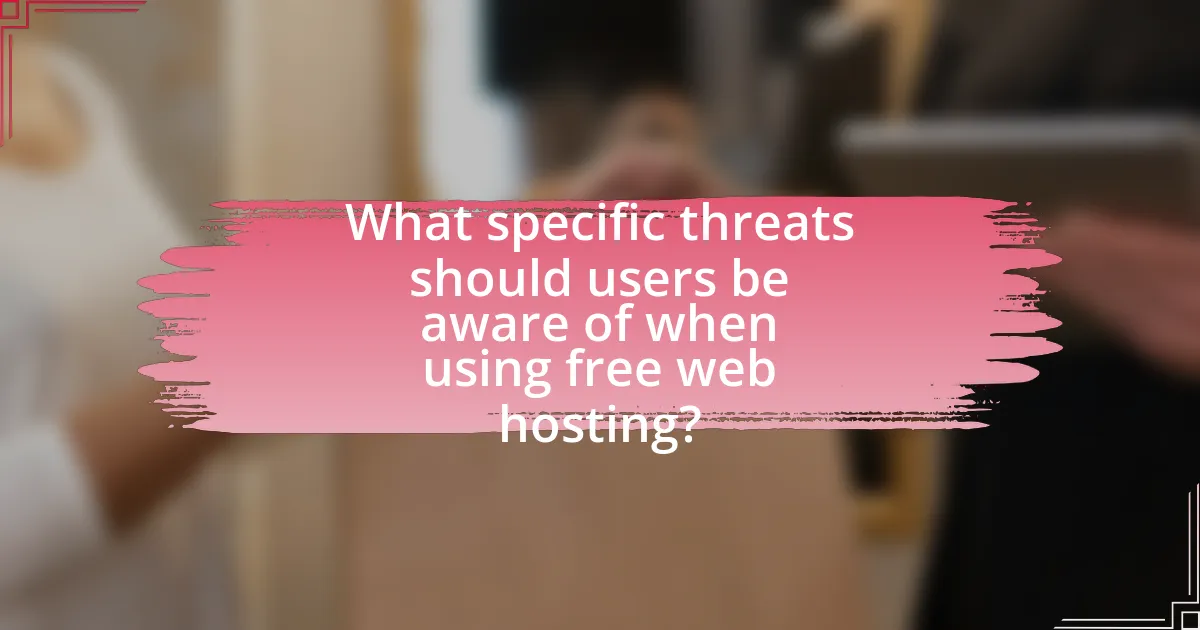
What specific threats should users be aware of when using free web hosting?
Users should be aware of several specific threats when using free web hosting, including data security risks, limited customer support, and potential for service interruptions. Data security risks arise because free hosting providers often lack robust security measures, making websites vulnerable to hacking and data breaches. Limited customer support can lead to unresolved issues, leaving users without assistance during critical times. Additionally, service interruptions are common with free hosting, as providers may prioritize paid accounts, resulting in downtime that can affect website accessibility and reliability.
How can malware affect websites hosted on free platforms?
Malware can severely compromise websites hosted on free platforms by injecting malicious code, which can lead to data breaches, unauthorized access, and the distribution of spam. Free hosting services often lack robust security measures, making them attractive targets for cybercriminals. For instance, a study by the Cybersecurity and Infrastructure Security Agency (CISA) highlighted that free hosting platforms are frequently exploited due to their limited security protocols, allowing malware to spread rapidly and affect not only the compromised site but also its visitors. This can result in loss of sensitive information, damage to the website’s reputation, and potential legal ramifications for the site owner.
What are the signs of malware infection on a free hosted site?
Signs of malware infection on a free hosted site include unexpected redirects, slow performance, and unusual pop-ups. These symptoms indicate that the site may be compromised, as malware often alters website behavior to serve malicious content or steal information. Additionally, if users report receiving warnings from their browsers about unsafe content or if there are unexplained changes to website files, these are strong indicators of a malware infection. According to a report by Symantec, 54% of websites infected with malware exhibit altered content or unexpected redirects, reinforcing the importance of monitoring for these signs.
How can users protect their sites from malware attacks?
Users can protect their sites from malware attacks by implementing strong security measures such as regular software updates, using web application firewalls, and employing robust security plugins. Regularly updating software, including content management systems and plugins, addresses vulnerabilities that malware can exploit. Web application firewalls act as a barrier between the website and potential threats, filtering out malicious traffic. Additionally, security plugins can provide features like malware scanning and real-time monitoring, which help detect and mitigate threats promptly. According to a report by the Cybersecurity & Infrastructure Security Agency, 60% of data breaches are linked to vulnerabilities that could be mitigated through timely updates and security measures.
What is the risk of phishing attacks with free web hosting?
The risk of phishing attacks with free web hosting is significantly heightened due to the lack of robust security measures and the potential for malicious users to exploit the platform. Free web hosting services often do not provide adequate protection against cyber threats, making it easier for attackers to create fraudulent websites that mimic legitimate ones. According to a report by the Anti-Phishing Working Group, 74% of phishing sites are hosted on free or low-cost hosting services, indicating a strong correlation between free hosting and phishing activities. This vulnerability arises from the minimal oversight and control that free hosting providers typically exercise over their users, allowing cybercriminals to operate with relative anonymity.
How can phishing schemes target users of free web hosting?
Phishing schemes can target users of free web hosting by exploiting the lack of security measures and trust associated with these platforms. Users often create websites with minimal verification, making it easier for attackers to set up fraudulent sites that mimic legitimate services. For instance, attackers can use similar domain names or subdomains to deceive users into entering sensitive information. According to a report by the Anti-Phishing Working Group, 74% of phishing sites are hosted on compromised servers, which often include free web hosting services. This vulnerability allows attackers to reach unsuspecting users who may not be aware of the risks associated with free hosting environments.
What measures can be taken to avoid falling victim to phishing?
To avoid falling victim to phishing, individuals should implement several key measures. First, they must verify the authenticity of emails and messages by checking the sender’s address and looking for inconsistencies. Research indicates that 91% of cyberattacks begin with a phishing email, highlighting the importance of scrutiny. Additionally, using multi-factor authentication adds an extra layer of security, making it harder for attackers to gain access even if credentials are compromised. Regularly updating software and security systems is crucial, as outdated systems are more vulnerable to phishing attacks. Finally, educating oneself and others about the latest phishing tactics can significantly reduce the risk of falling prey to such scams.
Why is website downtime a security concern for free hosting users?
Website downtime is a security concern for free hosting users because it can expose their sites to vulnerabilities and attacks during periods of unavailability. When a website is down, it may not receive timely security updates or patches, leaving it susceptible to exploitation by malicious actors. Additionally, downtime can lead to loss of data integrity and trust, as users may perceive the site as unreliable or compromised. Research indicates that 60% of small businesses experience a cyber attack within six months of a significant outage, highlighting the direct correlation between downtime and increased security risks.
How does downtime affect user trust and site reputation?
Downtime significantly undermines user trust and damages site reputation. When a website experiences frequent or prolonged outages, users perceive it as unreliable, leading to frustration and loss of confidence in the service. According to a study by the Ponemon Institute, 90% of users reported that they would abandon a website after experiencing just one instance of downtime. This abandonment not only affects immediate user engagement but also has long-term repercussions, as negative experiences can lead to poor reviews and decreased customer loyalty. Consequently, a site’s reputation suffers, making it harder to attract and retain users in the future.
What can users do to minimize downtime risks?
Users can minimize downtime risks by implementing regular backups and utilizing reliable monitoring tools. Regular backups ensure that data can be restored quickly in case of a failure, reducing the impact of downtime. According to a study by the National Archives and Records Administration, 93% of companies that experience a significant data loss go out of business within five years, highlighting the importance of data recovery strategies. Additionally, monitoring tools can provide real-time alerts about server performance and potential issues, allowing users to address problems proactively before they lead to downtime.
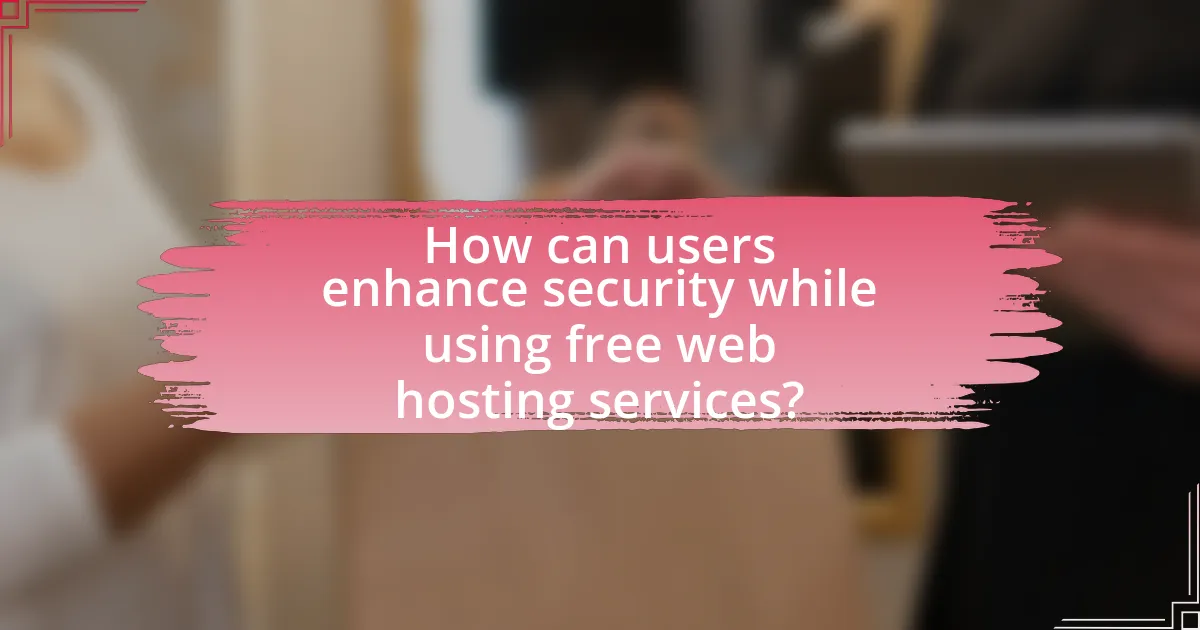
How can users enhance security while using free web hosting services?
Users can enhance security while using free web hosting services by implementing strong passwords and enabling two-factor authentication. Strong passwords reduce the risk of unauthorized access, while two-factor authentication adds an additional layer of security by requiring a second form of verification. According to a study by Verizon, 81% of data breaches are due to weak or stolen passwords, highlighting the importance of robust password practices. Additionally, users should regularly update their software and plugins to protect against vulnerabilities, as outdated systems are often targeted by attackers. Regular backups of website data also ensure that users can recover from potential security incidents.
What best practices should users follow for securing their free hosted sites?
Users should implement strong passwords and enable two-factor authentication to secure their free hosted sites. Strong passwords, consisting of at least 12 characters with a mix of letters, numbers, and symbols, significantly reduce the risk of unauthorized access, as studies show that 81% of data breaches are linked to weak passwords. Additionally, enabling two-factor authentication adds an extra layer of security, making it harder for attackers to gain access even if they have the password. Regularly updating software and plugins is also crucial, as outdated systems are often targeted by cybercriminals; according to a report by the Cybersecurity & Infrastructure Security Agency, 60% of breaches exploit known vulnerabilities. Lastly, users should regularly back up their data to mitigate the impact of potential attacks, as 30% of users who experience data loss never recover their data.
How important is regular software and plugin updates for security?
Regular software and plugin updates are crucial for security as they address vulnerabilities that could be exploited by attackers. Outdated software often contains known security flaws, and according to a report by the Cybersecurity & Infrastructure Security Agency (CISA), 85% of successful cyberattacks exploit known vulnerabilities for which patches are available. Keeping software and plugins updated mitigates these risks by ensuring that the latest security enhancements and fixes are applied, thereby protecting systems from potential breaches.
What role does strong password management play in site security?
Strong password management is critical for site security as it directly prevents unauthorized access to sensitive information. Effective password management practices, such as using complex passwords, regularly updating them, and employing password managers, significantly reduce the risk of breaches. According to a study by Verizon, 81% of hacking-related breaches leverage stolen or weak passwords, highlighting the importance of robust password strategies in safeguarding online platforms.
What tools and resources can help improve security on free web hosting?
To improve security on free web hosting, users can utilize tools such as Cloudflare for DDoS protection, SSL certificates for encrypted connections, and security plugins like Wordfence for WordPress sites. These tools enhance security by providing features like traffic filtering, secure data transmission, and malware scanning. For instance, Cloudflare reports that it mitigates millions of DDoS attacks daily, demonstrating its effectiveness in protecting websites. Additionally, using strong passwords and two-factor authentication can further safeguard accounts against unauthorized access.
How can security plugins enhance protection for free hosted websites?
Security plugins enhance protection for free hosted websites by providing essential features such as malware scanning, firewall protection, and login security. These plugins actively monitor website traffic for suspicious activity, block malicious requests, and protect against brute force attacks, which are common vulnerabilities in free hosting environments. For instance, a study by Sucuri found that 90% of websites infected with malware were running outdated software or lacked security measures, highlighting the importance of proactive security measures like those offered by plugins. By implementing these tools, website owners can significantly reduce the risk of data breaches and unauthorized access, ensuring a safer online presence.
What external services can provide additional security layers?
External services that can provide additional security layers include web application firewalls (WAFs), content delivery networks (CDNs) with security features, and managed security service providers (MSSPs). WAFs protect web applications by filtering and monitoring HTTP traffic between a web application and the internet, effectively blocking malicious traffic. CDNs enhance security by distributing content across multiple servers, which can mitigate DDoS attacks and improve load times. MSSPs offer comprehensive security solutions, including threat detection and response, ensuring continuous monitoring and management of security protocols. These services collectively strengthen the security posture of websites hosted on free platforms, which often lack robust built-in security measures.
What are the common troubleshooting steps for security issues in free web hosting?
Common troubleshooting steps for security issues in free web hosting include checking for malware, updating software, reviewing access logs, changing passwords, and ensuring proper permissions. These steps are essential because malware can compromise site integrity, outdated software may have vulnerabilities, access logs can reveal unauthorized access, weak passwords can be easily exploited, and incorrect permissions can expose sensitive files. Regularly performing these actions helps maintain a secure hosting environment and protects against potential threats.
How can users identify and resolve security vulnerabilities quickly?
Users can identify and resolve security vulnerabilities quickly by employing automated security scanning tools and regularly updating their software. Automated tools, such as Nessus or OpenVAS, can scan for known vulnerabilities in real-time, providing users with immediate feedback on potential security issues. Regular software updates are crucial, as they often include patches for newly discovered vulnerabilities, reducing the risk of exploitation. According to a report by the Cybersecurity & Infrastructure Security Agency (CISA), timely updates can mitigate up to 85% of known vulnerabilities, emphasizing the importance of proactive security measures.
What should users do if they suspect a security breach?
Users should immediately change their passwords and enable two-factor authentication if they suspect a security breach. This action helps to secure their accounts against unauthorized access. Additionally, users should monitor their accounts for any suspicious activity and report any findings to their service provider. According to the Cybersecurity & Infrastructure Security Agency, timely reporting can help mitigate the impact of a breach and assist in preventing further incidents.










